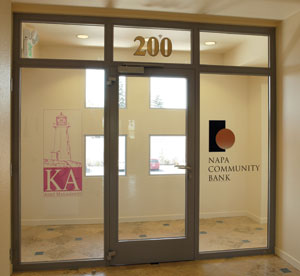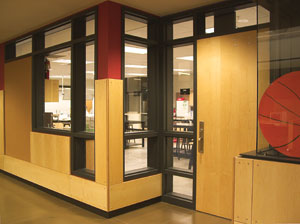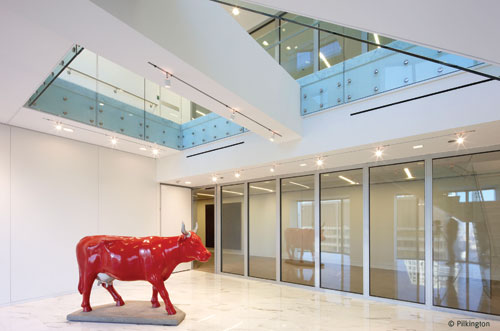Fire-Rated Glass and Framing Deliver Design Goals
 |
Depending on the product, fire-rated glazing can be etched on one side without affecting its fire-rating. Photo courtesy of Technical Glass Products |
Types of Fire-Rated Glass
Two main types of fire-rated glass currently on the market are fire-rated ceramic glass and transparent wall panels. A third type of fire-rated glass is wired glass that was used for years in institutional and commercial buildings to help hold glass together under high heat. It offered fire protection, but upon impact its wires could snag and cause injury. The 2006 code revisions specifically eliminate the use of traditional polished wired glass in hazardous locations where it is susceptible to impact and breakage, such as doors, sidelites and windows near the floor, in all types of buildings. Wired glass is now often used where budgets do not support higher performance and more aesthetic materials.
Fire-rated ceramic glass. This type of fire-rated glass carries fire protection ratings and protects against flames and smoke. But because ceramic glass transfers radiant and conductive heat, it should not be specified for installations where codes require a fire resistant or 'barrier to heat' rating. Fire-rated ceramic glass is, however, available in different products and product make-ups that meet many code requirements. For design professionals, modern fire-rated ceramic glass offers a number of aesthetic advantages. Since large glazed areas with no noticeable coloring and surface imperfections are now possible, it can be used in many more projects, especially where viewers may come in close proximity to the glass. Design benefits of new fire rated ceramic glass include:
- High visible light transmission (VLT) of approximately 88 percent
- Low reflectivity of about nine percent
- May be lightly sand-blasted or etched on one side without affecting fire-rating
- Offered in translucent patterned surfaces for privacy
- Reduced visible color
- Available in large sizes generally up to 3-ft. x 8-ft
- Available in a thin profile, typically 3/16-in., weighs approximately 2.4 lb/sq in.
(depending on product make-up) - Can fit in a standard size fire-rated frame
- Surface condition similar to ordinary glass
- Fire ratings from 20 minutes to 3 hours.
Specific product capabilities may vary depending on the make-up and brand. Check with the manufacturer for details.
 |
Fire-rated and safety-rated insulated glass units (IGUs) have smooth, high-clarity ceramic glass panels. Photo courtesy of Technical Glass Products |
Insulated glass units (IGUs). Fire-rated ceramic glass may be incorporated into insulated glass units (IGUs). Made up from ceramic glass panels with either tempered float glass (glass processed by controlled thermal or chemical treatments to increase its strength) or annealed float glass (glass slowly cooled to relieve internal stresses after it was formed) plus a dead air space, such IGUs offer fire-ratings in energy-efficient units. Depending on the product make-up, architects can specify them for interior or exterior applications. IGUs offer a wide range of appearances that include tinted, low-E, reflective, art glass and one-way mirrors.
Transparent wall panels. Transparent wall panels most notably differ from fire-rated ceramic glass in the form of fire resistant/heat barrier protection they provide. In some configurations, the panels incorporate multiple layers of glass with intumescent interlayers that turn to foam when exposed to heat and thus serve as a heat barrier with a fire-resistant rating. They defend against radiant and conductive heat in addition to providing a barrier to flames and smoke. For example, flames can rage on one side of the glass, while people or sensitive equipment on the other side remain protected from the heat and the glass remains cool to the touch. Potential applications include stairwells, elevator lobbies, doors, sidelites, transoms, borrowed lites (a glazed opening in a room with no exterior glazing that "borrows" natural light from adjoining space) and wall assemblies.
 |
Fire-rated full-lite doors and wall panels with narrow profile steel frames are listed and labeled with UL and ULC and meet heat barrier tests. Photo courtesy of Pilkington© |
Â
Aesthetically, transparent wall panels provide nearly the same level of clarity as ordinary float glass. Depending on the application, they may be suitable in floor-to-ceiling designs or for large expanses of glass. This can eliminate the need for opaque materials such as masonry or gypsum in areas that require fire-rated walls. For instance, rather than using solid materials in elevator shafts, stairwells and corridors, design professionals can incorporate glass wall panels in schools, museums, office buildings and other spaces to increase views and natural daylight. As with fire-rated ceramic glass, transparent wall panels can withstand certain surface treatments without performance loss. Applications and features of transparent wall panels include:
- Use for exit corridors, stairwells and areas where people could be trapped for long periods
- Suitable for protecting heat-sensitive equipment
- Solution for designs that call for large expanses of fire-rated glass
- Has impact-safety ratings
- Typical thickness ranges from 3/4-in. to 2-3/8-in. depending on fire-rating
- High visible light transmission (VLT) approximately 86 percent depending on product make-up
- Fire-ratings from 45 to 120 minutes
- Rated as fire-resistant heat barrier
- Available in insulated units with other glass products, including tinted, low-E, reflective, one-way mirror, etc.









